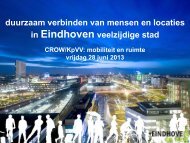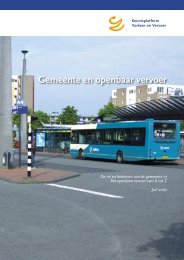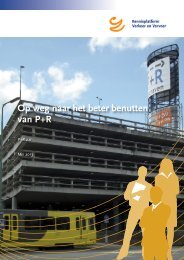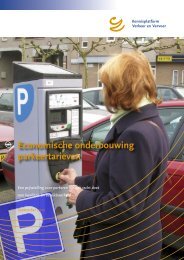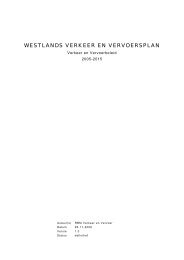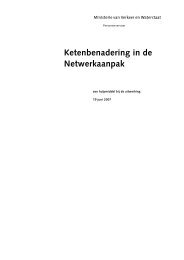BUNDELING: EEN GOUDEN GREEP? - KpVV
BUNDELING: EEN GOUDEN GREEP? - KpVV
BUNDELING: EEN GOUDEN GREEP? - KpVV
Create successful ePaper yourself
Turn your PDF publications into a flip-book with our unique Google optimized e-Paper software.
All in all, implementation of urban compaction policy is under pressure, as illustrated by a recent<br />
analysis of the New Map of the Netherlands (a digital interactive database with all completed and<br />
approved development plans in the Netherlands): building activities are increasing around motorway<br />
slip roads and declining around railway stations.<br />
An important objective of urban compaction policy has always been to curb car use. An international<br />
comparison is revealing: there does indeed appear to be a relation between urban compaction (in<br />
whatever form) and choice of transport mode. More compaction or clustering leads to greater use<br />
of public transport. High population densities in the cities are also connected with increased use of<br />
public transport, but this must be accompanied by a high level of service, supporting policies (such as<br />
strict parking regulations) and considerable patience. The city of Lyon in France is a good example of<br />
how public transport (in this case light rail) can provide the backbone for new urban development.<br />
Looking to the future, we see an increasingly mobile population. Besides commuter journeys, new<br />
forms of mobility associated with other activities are developing apace, including the fast growing<br />
leisure industry, and ‘pointless mobility’: driving somewhere just for the fun of it; the modern<br />
equivalent of sitting by a ditch and sucking on a straw. These new journeys make the roads busier<br />
and congestion less predictable.<br />
Not only can we expect traffic to increase, but it seems it will also become more difficult to steer<br />
developments through the adoption and execution of policy. To implement its policies, government<br />
is increasingly dependent on close cooperation with private parties, civil society organisations and<br />
individuals. Moreover, scenario studies by the Netherlands Bureau for Economic Policy Analysis<br />
indicate that policy measures have little quantitative effect: at best a few per cent reduction in<br />
mobility. The age of building major new motorways is over. Should we conclude, therefore, that soon<br />
we will all be stuck in the traffic queue? Luckily, no. Extra capacity can be gained by widening existing<br />
roads and completing the supporting road network, especially outside the Randstad. But regional<br />
and provincial authorities must actually receive sufficient funds to do this. In future, technological<br />
developments may also create more breathing space, although considerable thought will have to be<br />
given to their integration into existing structures and organisations. For public transport gains should<br />
be sought through better linkage between the various modes of transport, as has already been<br />
achieved by Randstadrail.<br />
9<br />
B U N D E L I N G : E E N G O U D E N G R E E P ?<br />
In the field of policy there seems to be a future in seeking to adjust the socio-economic characteristics<br />
of groups and individuals instead of focusing just on locational issues. For example, a highly-qualified<br />
full-time employee with children is twice as mobile as the average person; a pensioner living in rural<br />
East Groningen in the far north of the country is much less mobile. For urban compaction policy<br />
specifically, it will prove difficult to check and reverse the socially-driven flight from the central urban<br />
areas in the usual way, with hefty policy documents. But the growing level of public engagement<br />
(e.g. NIMBY), in combination with more coercive European regulations, could effecti-vely bridge that<br />
gap. The most important development in the future of urban compaction policy, though, will be<br />
relaxing the hold of spatial units and giving more emphasis to steering people’s behaviour. We could<br />
see numerous ‘new style’ compaction deals. For example, a transport company and property<br />
developer could enter into a joint venture for the development of offices in a (highly accessible by<br />
public transport) location. Instead of a restricting condition, urban compaction would then be a<br />
quality in itself.




